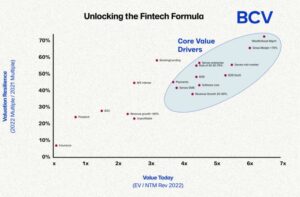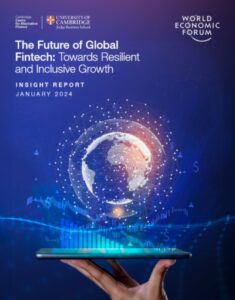Report Insights | Jan 18, 2024
In a recent episode of The McKinsey Podcast, senior partners Alex Edlich and Reinhard Hüll, along with editorial director Roberta Fusaro, delve into the findings of McKinsey's 2023 Global Banking Annual Review. The discussion centers on the evolving landscape for banks, highlighting the profitable yet challenging period for the global banking industry. Below we highlight the key trends on the changing landscape for banks have significant implications for fintechs and investors.
Key Trends and Insights
1. More than half of the $402 trillion in global financial assets is not on bank balance sheets
The report underscores a major asset shift in the banking sector: a substantial portion of assets, over $402 trillion globally, now resides outside traditional bank balance sheets. This transition, largely towards mutual funds, insurance, pension funds, and private capital, marks a significant change in the financial ecosystem.
See: Open Banking: Revolutionizing Financial Data Sharing
- There's a vast opportunity for fintechs to innovate in areas like asset management, insurance, pension funds, and private capital. Fintechs can leverage their agility and technological prowess to create solutions that cater to this shift.
- Shifting assets across geographies suggests that fintechs and investors should consider a global perspective. Markets like the Indo-Crescent region are emerging as hotspots for banking performance, which could be fertile ground for fintech innovation and investment.
2. Rising interest rates have boosted banking sector profits by about $280 billion in 2022
While rapidly rising interest rates has resulted in the higher profits for the global banking industry (best period since 2007), it's crucial for banks to recognize and adapt to the ongoing structural and macroeconomic changes, and look to evolve with market dynamics. The rise in interest rates also presents an opportunity for fintechs.
See: Minerva & Equifax Canada Partner on AML Solutions
- They can develop financial products that capitalize on these higher rates, offering more attractive returns to their customers. By integrating advanced technologies into their services, fintechs can enhance customer experience, improve operational efficiency, and offer innovative products.
- "We’re talking about gen AI and stuff you can implement pretty quickly."
3. Up to 30 percent of distribution in retail banking going via third parties
The podcast also touches on the increasing role of consumer digital payments and embedded finance, indicating a shift towards more mobile and web-based banking interactions. This transition necessitates banks to rethink their distribution strategies, potentially leveraging third-party platforms and enhancing their technological capabilities.
- The move towards digital payments and embedded finance, with a significant portion of retail banking distribution going through third parties, opens new avenues for fintechs. They can position themselves as key players in these channels, offering seamless and integrated financial services.
- As the banking sector grapples with various risks, including those associated with technology and cyber threats, fintechs that offer solutions in risk management, cybersecurity, and compliance will be increasingly valuable. Investors should look for companies that are strengthening the financial sector's resilience to these challenges.
So What Should Banks Do?
Prioritize technological integration and innovation, focusing on digital transformation and customer-centric services. Embrace the shift towards digital and mobile banking, leveraging AI and data analytics to enhance customer experience and operational efficiency.
See: Canadian Banks Face Scrutiny Over Sustainability Claims
Actively explore partnerships with fintechs to stay ahead in the rapidly evolving financial landscape, ensuring our bank remains competitive, resilient, and adaptable to the changing needs and behaviors of our customers. This strategic focus is not just about keeping pace; it's about leading the industry into its next chapter.
And What Should Fintechs Do?
Fintechs should focus on strategic collaborations and niche market innovation. Capitalize on your agility and technological edge to create solutions that address gaps in traditional banking, particularly in areas like digital payments, personalized financial services, and cybersecurity. Forge strategic partnerships with established banks to gain scale and market access, while maintaining your innovative spirit. This approach will not only enhance your value proposition but also position you as indispensable players in the evolving financial ecosystem, driving the future of finance through innovation and customer-centric solutions.
Outlook
With over half of global financial assets moving outside traditional bank balance sheets, rising interest rates boosting profits, and a significant shift towards third-party distribution channels, the landscape is rapidly evolving. These trends not only challenge the status quo of traditional banking but also open up unprecedented opportunities for fintechs and investors.
See: Discover the Future of Finance with Michael King’s “Fintech Explained”
In conclusion, the future of banking and finance is being rewritten, with technology and innovation at its core. Both banks and fintechs have pivotal roles to play in this new era. For investors, this represents a landscape ripe with opportunities for those who can navigate these changes effectively. As the industry continues to evolve, the focus should be on adaptability, innovation, and strategic collaboration, driving the future of finance through customer-centric solutions and technological advancements.

 The National Crowdfunding & Fintech Association (NCFA Canada) is a financial innovation ecosystem that provides education, market intelligence, industry stewardship, networking and funding opportunities and services to thousands of community members and works closely with industry, government, partners and affiliates to create a vibrant and innovative fintech and funding industry in Canada. Decentralized and distributed, NCFA is engaged with global stakeholders and helps incubate projects and investment in fintech, alternative finance, crowdfunding, peer-to-peer finance, payments, digital assets and tokens, artificial intelligence, blockchain, cryptocurrency, regtech, and insurtech sectors. Join Canada's Fintech & Funding Community today FREE! Or become a contributing member and get perks. For more information, please visit: www.ncfacanada.org
The National Crowdfunding & Fintech Association (NCFA Canada) is a financial innovation ecosystem that provides education, market intelligence, industry stewardship, networking and funding opportunities and services to thousands of community members and works closely with industry, government, partners and affiliates to create a vibrant and innovative fintech and funding industry in Canada. Decentralized and distributed, NCFA is engaged with global stakeholders and helps incubate projects and investment in fintech, alternative finance, crowdfunding, peer-to-peer finance, payments, digital assets and tokens, artificial intelligence, blockchain, cryptocurrency, regtech, and insurtech sectors. Join Canada's Fintech & Funding Community today FREE! Or become a contributing member and get perks. For more information, please visit: www.ncfacanada.org Related Posts
- SEO Powered Content & PR Distribution. Get Amplified Today.
- PlatoData.Network Vertical Generative Ai. Empower Yourself. Access Here.
- PlatoAiStream. Web3 Intelligence. Knowledge Amplified. Access Here.
- PlatoESG. Carbon, CleanTech, Energy, Environment, Solar, Waste Management. Access Here.
- PlatoHealth. Biotech and Clinical Trials Intelligence. Access Here.
- Source: https://ncfacanada.org/evolving-banking-landscape-asset-shift-interest-rates-distribution/
- :has
- :is
- :not
- $UP
- 150
- 200
- 2018
- 2023
- 30
- 300
- a
- About
- access
- across
- adapt
- address
- advanced
- advancements
- affiliates
- ahead
- AI
- alex
- along
- also
- alternative
- alternative finance
- AML
- an
- analytics
- and
- annual
- approach
- ARE
- areas
- artificial
- artificial intelligence
- AS
- asset
- asset management
- Assets
- associated
- At
- attractive
- avenues
- Balance
- balance sheets
- Bank
- Banking
- Banking and Finance
- banking industry
- banking sector
- Banks
- BE
- become
- being
- below
- BEST
- Billion
- blockchain
- Boosted
- boosting
- both
- but
- by
- cache
- CAN
- Canada
- Canadian
- capabilities
- capital
- capitalize
- cater
- Centers
- challenge
- challenges
- challenging
- change
- Changes
- changing
- channels
- Chapter
- claims
- closely
- collaboration
- collaborations
- community
- Companies
- competitive
- compliance
- conclusion
- Consider
- consumer
- continues
- Core
- could
- create
- Crowdfunding
- crucial
- cryptocurrency
- customer
- customer experience
- Customers
- cyber
- Cybersecurity
- data
- Data Analytics
- data sharing
- decentralized
- delve
- develop
- digital
- Digital Assets
- Digital Payments
- Digital Transformation
- Director
- discover
- discussion
- distributed
- distribution
- do
- driving
- dynamics
- ecosystem
- Edge
- Editorial
- Education
- effectively
- efficiency
- embedded
- Embedded Finance
- embrace
- emerging
- engaged
- enhance
- enhancing
- ensuring
- episode
- Equifax
- Era
- established
- Ether (ETH)
- evolve
- evolving
- experience
- explore
- Face
- finance
- financial
- financial data
- financial innovation
- financial products
- Financial sector
- financial services
- findings
- fintech
- fintech innovation
- fintechs
- Focus
- focusing
- For
- forge
- from
- funding
- funding opportunities
- funds
- future
- Gain
- gaps
- Gen
- geographies
- get
- Global
- Global Banking
- global financial
- Globally
- going
- Government
- Ground
- Half
- Have
- helps
- High
- higher
- Highlight
- highlighting
- http
- HTTPS
- image
- implement
- implications
- improve
- in
- Including
- increasing
- increasingly
- indicating
- industry
- information
- innovate
- Innovation
- innovative
- insights
- insurance
- Insurtech
- integrated
- Integrating
- integration
- Intelligence
- interactions
- interest
- Interest Rates
- into
- investment
- Investors
- IT
- ITS
- Jan
- jpg
- just
- keeping
- Key
- landscape
- largely
- leading
- leveraging
- like
- Look
- Macroeconomic
- maintaining
- major
- management
- Market
- Markets
- max-width
- McKinsey
- Meets
- member
- Members
- Michael
- Mobile
- Mobile banking
- more
- move
- moving
- mutual
- mutual funds
- Navigate
- needs
- networking
- New
- next
- niche
- now
- of
- offer
- offering
- on
- ongoing
- only
- open
- open banking
- opens
- operational
- opportunities
- Opportunity
- or
- our
- outside
- over
- Pace
- particularly
- parties
- partner
- partners
- partnerships
- payments
- peer to peer
- pension
- percent
- performance
- period
- perks
- Personalized
- pivotal
- Platforms
- plato
- Plato Data Intelligence
- PlatoData
- Play
- players
- please
- podcast
- portion
- position
- potentially
- presents
- pretty
- private
- Products
- profitable
- profits
- projects
- proposition
- provides
- quickly
- rapidly
- Rates
- recent
- recognize
- region
- Regtech
- remains
- report
- represents
- resilience
- resilient
- resulted
- retail
- Retail Banking
- returns
- Revolutionizing
- Rise
- rising
- Risk
- risk management
- risks
- Role
- roles
- s
- Scale
- scrutiny
- seamless
- sector
- Sectors
- senior
- Services
- sharing
- shift
- should
- significant
- since
- Solutions
- spirit
- stakeholders
- Status
- stay
- Stewardship
- Strategic
- Strategic Partnerships
- strategies
- strengthening
- structural
- substantial
- Suggests
- Sustainability
- talking
- technological
- Technologies
- Technology
- than
- that
- The
- The Future
- The Landscape
- their
- themselves
- These
- they
- Third
- third parties
- third-party
- this
- those
- thousands
- threats
- Through
- to
- today
- Tokens
- touches
- towards
- traditional
- traditional banking
- Transformation
- transition
- Trends
- Trillion
- underscores
- unprecedented
- value
- value proposition
- various
- Vast
- via
- vibrant
- Visit
- we
- web-based
- What
- which
- while
- WHO
- will
- with
- works
- yet
- you
- Your
- zephyrnet













